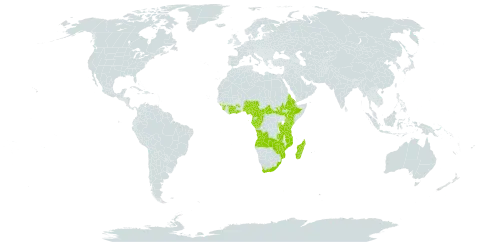A semi-succulent straggling or scrambling shrub up to 4 m., sometimes climbing up to 6–9(–18) m., glabrous or less commonly crisped pubescent on the vegetative parts.. Leaf-blades ovate to elliptic, 6–15 cm. long, 3–8.5(–10) cm. wide, narrowed to a prominently and ultimately recurved mucronate tip, cuneate, rounded or cordate to the shortly decurrent unequal-sided base, glossy, with translucent margins (at least when dry); crystals visible as short raised lines and dots on the younger leaves; primary lateral nerves 4–8 on either side; petioles mostly 1.5–4 cm. long.. Racemes shortly pedunculate, ± 15–30(–40) cm. long, subdensely very many-flowered, usually crisped pubescent except often towards the base; bracts subulate to linear-lanceolate, 1–2 mm. long; pedicels 1.5–5(–10) mm. long, longest in long-staminate flowers, with small bracteoles near the middle or above.. Flowers dimorphic, scented.. Long-staminate flowers white or cream; stamens (10–)12–15; filaments 3–4(–5) mm. long; anthers oblong-elliptic, 0.8–1.2 mm. long; carpels ± half as long as the filaments and only very rarely developing.. Short-staminate flowers yellowish-green; stamens 8–15, with 1–1.5 mm. long filaments and rather smaller anthers; carpels (4–)5(–8), obliquely flattened-ovoid, united only at the base.. Sepals triangular-lanceolate to ± oblong or ovate-oblong, bluntly pointed, 2–3 mm. long, slightly fleshy, pubescent at least along the margins, becoming reflexed.. Berry bluntly star-shaped in outline, the free part of the swollen carpels spreading, with the style-bases at the points, becoming more rounded, juicy and ripening orange or red, 5–8 mm. across.. Seeds lenticular, 2.5–3(?–4) mm. across, papillate and striate towards the hilum, glossy black.. Fig. 1.
Scrambling shrub, 1.5-4.0 m high; semi-succulent. Leaves petioled, ovate to broadly elliptic, base broadly cuneate, oblique, apex ± acute. Inflorescences terminal or lateral racemes. Flowers functionally unisexual, yellowish green; pedicels up to 10 mm long. Sepals reflexed at anthesis. Stamens 10-20 in 1 or 2 whorls; flowers dimorphic, long and short staminate. Carpels 4 or 5, upper part of carpels free; styles widened at base. Flowering time Feb.-July. Fruit 4 or 5 drupelets, style remains pointing outwards at apex of each carpel, orange to red and fleshy when ripe. Seeds 2-3 mm in diam., discoidal; testa shiny black.
Short staminate flowers: functionally female; stamens 1.5–3.0 mm. long; filaments 1–2.5 mm. long; anthers 0.5–1.0 × 0.25–0.5 mm., circular to oblong; carpels 4–5, 1.5–2 mm. tall, ovoid, connate at base only, pubescent; styles 0.75–2 mm. long, widening towards base, turned outwards, pubescent to glabrescent; stigmas linear.
Long staminate flowers: usually functionally male but sometimes developing fruit; stamens 3–6.5 mm. long; filaments 3–5 mm. long; anthers 0.5–1 × 0.5–0.75 mm.; carpels 4–5, 1–1.5 × 0.75–1 mm., ovoid, connate at base only; styles 0.5–1.0 mm. long, linear, broadening at base, pubescent to glabrescent; stigmas linear.
Leaves: lamina 3–14 × 1.5–9.5 cm., ovate to broadly elliptic, base rounded to broadly cuneate, usually oblique, often slightly decurrent, apex acute or rounded with olten recurved mucronate point or retuse, glabrous to pubescent; petioles 8–40 mm. long, pubescent to glabrous.
Fruit usually developed in short-staminate flowers only, 4–5 (8) lobed, 5–10 mm. in diam., ripening orange or red, each carpel 3.5–5 × 2.5–4 mm., fleshy, remains of style pointing outwards at apex of each carpel, pubescent to glabrous.
Sepals 2–4 × 1–2 mm., narrowly triangular to oblong ovate, acute, pubescent outside, pubescent to glabrous inside, reflexed at anthesis.
Herbs or shrubs sometimes scrambling or trailing up to 10–13 m. (20 m.), semi-succulent, sometimes forming dense thickets.
Seeds 2–3 mm. in diam., discoidal, sometimes with ridged edge around circumference; testa shiny black.
Bracteoles usually on middle or upper part of pedicels, 0.5–1.5 (3) mm. long, subulate, pubescent.
Stamens 10–20 in 1–2 whorls; filaments-filiform, broadening towards base, pubescent to glabrous.
Inflorescences terminal and lateral racemes, leaf-opposed, 5–30 cm. long, rhachis pubescent.
Flowers dimorphic, usually functionally unisexual, whitish to yellowish green.
Stems usually glabrous, more rarely pubescent.
Disk 1.5–2 mm. in diam., more or less fleshy.
Bracts 1–2.5 mm. long, subulate, pubescent.
Pedicels 5–8 (10) mm. long, pubescent.
